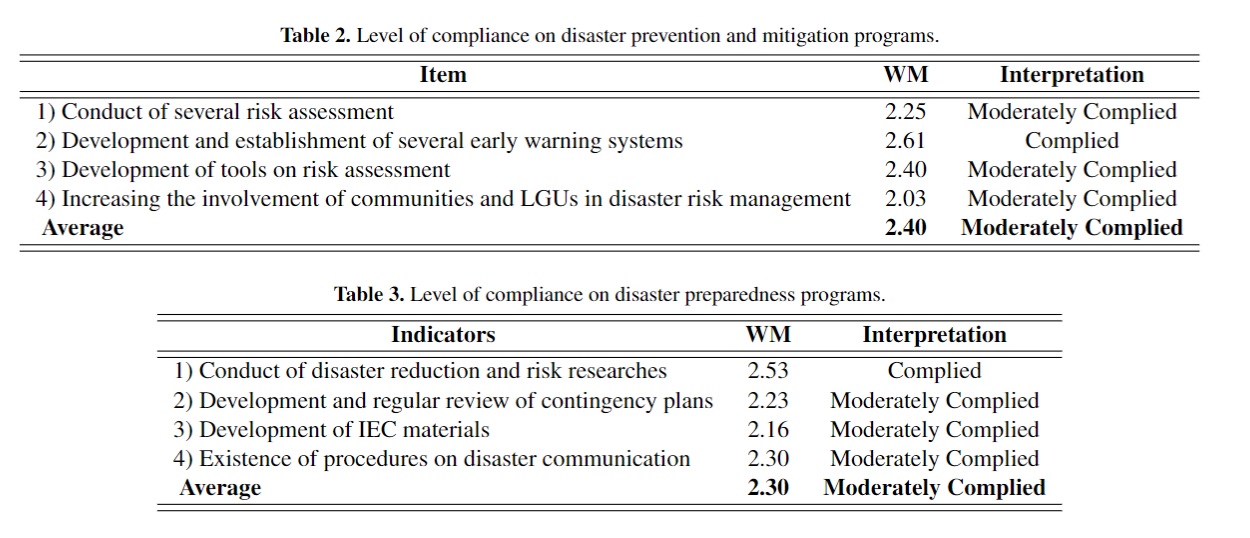Disaster management program compliance and problems encountered in two provinces in Central Luzon, Philippines
Main Article Content
Abstract
Disaster management is one area in the field that comes with a heavy burden of administrative functions and compliances. Thus, it is vital to consider among managers to put the best man in the field. The purpose of this study is to find out the disaster management program compliance of participants in two provinces in Central Luzon, Philippines. At the same time, identify the problems encountered during the implementation of the programs. This study used a descriptive design with the survey as a primary instrument in data gathering. 110 participants took part in the survey which came from the two selected provinces. The researcher created a questionnaire for the study which underwent validity and reliability test. This study analyzed the gathered data using SPSS 20 and employed the following statistical tools: frequency, percentage, rank, means, t-test, ANOVA, and Pearson-r. The study found that the respondents ``moderately complied'' with disaster prevention and mitigation programs and disaster preparedness programs. On the other hand, respondents ``complied'' with the disaster response programs and disaster recovery and rehabilitation programs. There were no statistical differences in the responses of respondents with different disaster management programs. However, there is a significant relationship between the number of family members and disaster response programs. Based on the results of the study, the researcher recommended pertinent suggestions for the community, policy-makers, and local government units.
Article Details

This work is licensed under a Creative Commons Attribution-NonCommercial-NoDerivatives 4.0 International License.
References
G. Roder, T. Ruljigaljig, C. W. Lin, P. Tarolli, Natural hazards knowledge and risk perception of Wujie indigenous community in Taiwan, Natural Hazards 81 (2016) 641 - 662.
R. M. Mercado, R.M., People's risk perceptions and responses to climate change and natural disasters in BASECO compound, Manila, Philippines, Procedia Environmental Sciences 34 (2016) 490 - 505.
A. Madan, J. K. Routray, Institutional framework for preparedness and response of disaster management institutions from national to the local level in India with focus on Delhi, International Journal of Disaster Risk Reduction 14 (2015) 545 - 555.
P. M. Orencio, M. Fujii, A spatiotemporal approach for determining disaster-risk potential based on damage consequences of multiple hazard events, Journal of Risk Research 17(7) (2014) 815 - 836.
M. N. Huda, Understanding indigenous people's perception of climate change and climatic hazards: a case study of Chakma indigenous communities in Rangamati Sadar Upazila of Rangamati District, Bangladesh, Natural Hazards 65(3) (2013) 2147 - 2159.
U. Habiba, R. Shaw, M. A. Abedin, Community-based disaster risk reduction approaches in Bangladesh, Disaster Risk Reduction Approaches in Bangladesh (2013) 259 - 279.
E. Espina, M. T. Calleja, A social-cognitive approach to disaster preparedness, Philippine Journal of Psychology 48(2) (2015) 161 -- 174.
T. Izumi, R. Shaw, Civil society and knowledge, education, and training in risk reduction, Civil Society Organization and Disaster Risk Reduction (2014) 115 - 133.
R. Deykota, T. Marassini, G. Cockfield, L.P. Deykota, Indigenous knowledge for climate-change-induced flood adaptation in Nepal, International Journal of Climate Change: Impacts and Responses 5(1) (2013) 35 - 46.
K. E. MacNamara, S. S. Prasad, Coping with extreme weather: communities in Fiji and Vanuatu share their experiences and knowledge, Climate Change 123(2) (2014) 121 - 132.
N. G. Iloka, Indigenous knowledge for disaster risk reduction: an African perspective, Jamba: Journal of Disaster Risk Studies 8(1) (2016) 1 - 7.
S. N. A. Codjoe, G. Owusu, V. Burkett, Perception, experience, and indigenous knowledge of climate change and variability: the case of Accra, s sub-Saharan African city, Regional Environmental Change 14(1) (2014) 369 - 383.
E. G. De Leon, J. Pittock, Integrating climate change adaptation and climate-related disaster risk-reduction policy in developing countries: a case study in the Philippines, Climate and Development 9(5) (2017) 471 - 478.
I. A. Ayala, A. R. Moreno, Landslide risk perception and communication for disaster risk management in mountain areas of developing countries: a Mexican foretaste, Journal of Mountain Science 13(12) (2016) 2079 - 2093.
J. Horney, M. Simon, S. Grabich, P. Berke, Measuring participation by socially vulnerable groups in hazard mitigation planning, Bertie County, North Carolina, Journal of Environmental Planning and Management 58(5) (2014) 802 - 818.
D. Misanya, A. O. Oyhus, How communities' perceptions of disasters influence disaster response: managing landslides on Mount Elgon, Uganda, Disasters 39(2) (2015) 389 - 405.
C. M. Kenney, S. R. Phibbs, D. Paton, J. Reid, D. M. Johnston, Community-led disaster risk management: A Maori response to Otautahi (Christchurch) earthquakes, Australasian Journal of Disaster and Trauma Studies 19(1) (2015) 9 - 20.
C. Rivera, H. Tehler, C. Wamsler, Fragmentation in disaster risk management system: A barrier for integrated planning, International Journal of Disaster Risk Reduction 14 (2015) 445 - 456.
M. Hsu, R. Howitt, F. Miller, Procedural vulnerability and institutional capacity deficits in post-disaster recovery and reconstruction: Insights from Wutai Rukai experiences of Typhoon Morakot, Human Organization: Winter 2015 74(4) (2015) 308 - 318.
S. N. M. Dalisay, Engaging local knowledge for disaster risk reduction, Kasarinlan: Philippine Journal of Third World Studies 29(2) (2014) 75 - 102.
S. K. Paul, M. N. Routray, People's perception about flood disaster management in Bangladesh: a case study on the Chalan Beel area, Stanford Journal of Environment and Human Habitat 2 (2013) 72 - 86.
C. M. Kenney, S. Phibbs, A Maori love story: community-led disaster management in response to the Otautahi (Christchurch) earthquakes as a framework for action, International Journal of Disaster Risk Reduction 14(1) (2015) 46 - 55.
G. Tuladhar, R. Yatabe, R. K. Dahal, N. P. Bhandary, Disaster risk reduction knowledge of local people in Nepal, Geoenvironmental Disasters 2 (2015).
R. Ndille, J. A. Belle, Managing the Limbe flood: considerations for disaster risk reduction in Cameroon, International Journal of Disaster Risk Science 5 (2014) 147 - 156.


